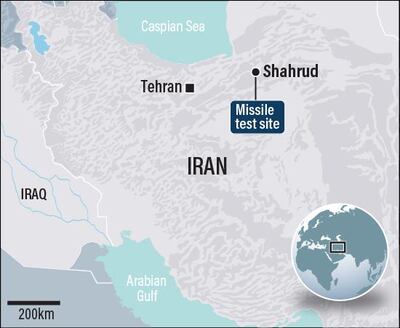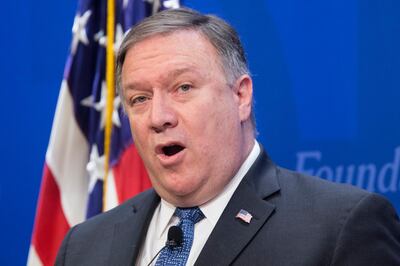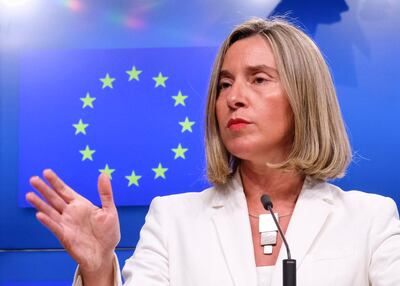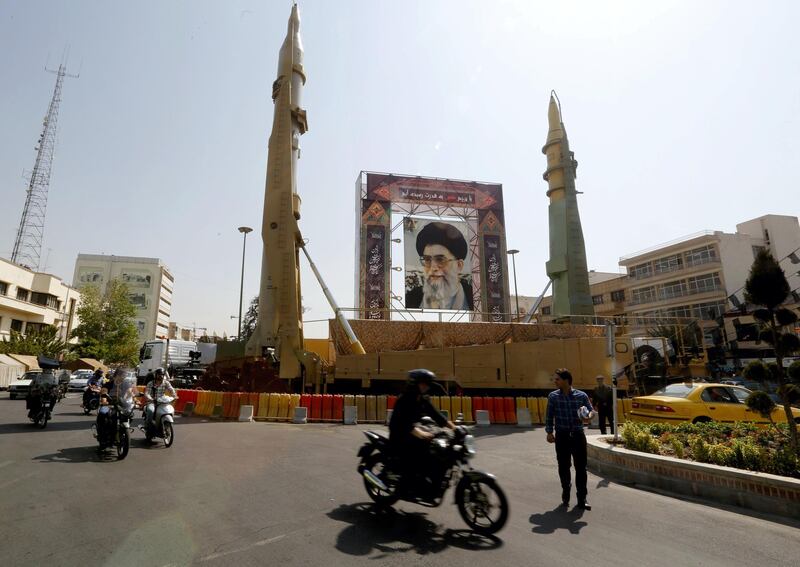A report detailing previously undisclosed dimensions of Iran's missile programme places western and northern Europe within the Islamic Republic’s potential line of fire, and could change the calculations of countries trying to preserve the 2015 nuclear deal with Tehran, say non-proliferation and security experts.
Iran's short and medium-range missile programme has worried countries in the Middle East and Arabian Peninsula for years. US Secretary of State Mike Pompeo on May 21 listed an end to Iran's proliferation of rockets and development of nuclear-capable missiles among 12 demands he said Tehran must meet in exchange for sanctions relief following the Trump administration's withdrawal from the nuclear agreement.
Research by scientists published in The New York Times last week suggested Iran has been developing long-range, solid-fuel missile technology at a known missile test facility near the northeast town of Shahrud. Such a new security dimension could weigh on diplomacy being conducted by the European Union, Russia, and China over the Iran deal, formally known as the Joint Comprehensive Plan of Action.
"If it's intercontinental ballistic missile work, it's of course worrying," said Paulina Izewicz, an expert on Iran's missile programme at the James Martin Center for Nonproliferation Studies.
"From the European perspective, it would change the calculus. In the JCPOA, the nuclear dimension was the main issue. But that was when the range of Iranian missiles was not as concerning."
Iran has not yet specifically responded to the report about its alleged missile work. The scientists at the Middlebury Institute of International Studies in California based their conclusions on analysis of satellite imagery and Iranian wire service photographs.

_____________
Iran developing new missile capabilities, US researchers say
Iran accuses US of breaking promises
_____________
Iran's defence minister Amir Hatami, however, has since said the country's missile programme will continue, regardless of American or other international pressure.
His comments came during a symbolically potent ceremony marking the recovery of the southwest Iranian city of Khorramshahr during the Iran-Iraq war.
Iran began investing in missile development during that 1980-1988 conflict, after it had been outmatched by Iraqi aircraft and SCUD rockets from Saddam Hussein's regime in Baghdad.
It was a period of trauma that continues to haunt Iranians who lived through it.
Having been placed under an arms embargo, Iran purchased missiles off the global black market from Libya, Syria and North Korea.
As Tehran also watched regional rivals beef up their military capacity with cutting edge American hardware, it sought to refine domestically-produced missiles as a deterrent.
Unlike the Iranian nuclear programme, the missile drive – until recently – was largely ignored. UN Security Council resolution 1929, passed eight years ago, had tightened proliferation-related sanctions on Tehran, banned the Islamic republic from carrying out tests of nuclear-capable ballistic missiles, and imposed an embargo on the transfer of major weapons systems.
By that time Iran had modified North Korean designs and developed its own projectiles, including Sajjil 2 rockets, tested in 2008, with a range of 2,000km that could reach Europe's southeast fringes.
In the late 1990s and early 2000s, Iran began developing short-range missiles powered by solid fuel, considered more tactically advantageous because they can be quickly launched without refuelling.
Yet non-proliferation experts say much of Iran's missile technology is outdated, questioning whether even the latest claims about a purported long-range missile programme, if confirmed, would give a tactical edge.
Building solid-fuel missiles on a large scale is an extremely delicate process, involving not only access to sensitive materials but also a reliable quality control mechanism.
_____________
Read more:
[ US sanctions five Iranians over ballistic missile deliveries to Yemen’s Houthis ]
US sanctions on Revolutionary Guards causes Iran investment rethink
Pompeo’s hardline stance walks a fine line between a new deal and all-out war with Tehran
_____________
"The operational reliability of any of these long-range missiles is questionable," said Bharath Gopalaswamy, director of the South Asia programme at the Atlantic Council in Washington, as well as a former aerospace engineer. "It's one thing to operate the missile, another to deploy it, and another to see how reliable these missiles are."
Regardless, enhancements to the missile programme could have an immediate effect.
"If Iran is secretly doing this, it would play into the hands of critics of the Iran deal saying, 'We told you so,'" said Mr Gopalaswamy.
"The Europeans genuinely have to be worried about this because they sit right on the front line."
Some experts worry that Iran's drive for more advanced missile capability could intensify a new regional arms race, potentially more dangerous than a battle involving ground troops or fighter jets.
"An offensive missile capability shortens the escalation ladders," said David Des Roches, an associate professor at the Near East South Asia Center for Strategic Studies, a think tank of the Department of Defense.
"Instead of a pinprick tactical back and forth, you have potential strategic wars. Instead of an incident at sea, you have a barrage of missiles at US bases. Israel hits targets in Syria, and the Iranian response would be, 'Fine, we have to fire missiles at Tel Aviv.'" Iran, having seen its parliament attacked by ISIS gunmen in Tehran last year, used six surface to surface mid-range missiles to hit the militant group in the Syrian city of Deir Ezzor.

The scientists who examined evidence about the Shahrud site have concluded that it is not a mass production facility, but more likely a testing ground.
Michael Elleman, a senior fellow for missile defence at the International Institute for Strategic Studies, estimated that Iran was five to 10 years away from having the technology to build a missile that could reach the United States or Western Europe.
"The Iranians always pursue a hedging strategy," Mr Elleman, a former Lockheed Martin rocket scientist, told The National.
"If they decide later on to build a nuclear weapon and have long range delivery this would be the start of what you'd want to do. But it's going to take them that long to master all this technology and produce anything."
However, building up an arsenal regardless of range, accuracy, or reliability can have an immediate strategic effect.
"Sending a couple of Burqan missiles to the Houthis keeps the Saudis on their toes," said Mr Elleman, referring to the rockets Iran is said to have supplied to the rebels in Yemen, which have been fired at Riyadh.
Theodore Karasik, an analyst at Gulf States Analytics, a security consulting firm, agreed, stressing that the fear of missiles falling on cities can alter a nation's calculations. It was one of the lessons Iran itself learned during the war with Iraq.
"Missiles can be a psychological tool," he said.
___________
Iran missile strike on ISIS has wider significance
___________
Regardless of its outcome pursuing a long-range missile programme raises the stakes in the three-way tussle between the US, Iran and Europe, which is under pressure from Washington to abide by American sanctions to maintain trade ties while at the same time facing a potential collapse of the nuclear deal.
A European diplomat currently overseeing Middle East issues told The National the scientists' purported discovery at Shahrud would likely have little effect on the commitment by France, Germany, Britain and other countries to save the nuclear deal, though it may put pressure on them to consider talks about the missile issue.
"The first and most urgent issue is salvaging the nuclear deal," he said. "The ballistic missile is is something to be talked about."
US intelligence assessments services have long concluded that Iran was seeking a long-range capability.
"Tehran's desire to deter the United States might drive it to field an ICBM," said one such recent document.
Sir Richard Dalton, who served as Britain's envoy to Iran between 2003 and 2006, said unclassified intelligence summaries "always say that long-range missiles appears to be a long term aim but they are not close – or working in such a way as to get close."
The report, he predicted, will not alter EU policy.

"The US want to encourage the French and others to be resolute in demanding a new agreement with Iran on missiles and to feed the hype," he said.
"Extra sanctions pressure possibly, but I doubt it. The EU priority is to save the nuclear deal and to do that they have to find positive things to do from Iran's economic and political point of view."
But others were less certain that revelations about Iran's missile capabilities might not affect the ongoing talks, which also involve Russia and China, about how to blunt the impact of US sanctions.
Europe's diplomatic corps has for years been divided between regional specialists sympathetic to the security concerns of Iran and other countries, and non-proliferation strategists who take a harder line.
"With the new disclosures they may have more capabilities than we thought," said Pieter Cleppe, a Brussels-based analyst at Open Europe, a security and intelligence think tank.
"They might be tempted to go with the thinking that while renegotiating the deal might incur some risks, not doing anything might be more risky."
This has played out in the rift within Europe between French President Emmanuel Macron and the EU's foreign policy chief Federica Mogherini over the threat of Iran’s missile programme, said Tytti Erasto, a nonproliferation specialist at the Stockholm International Peace Research Institute.
_________
EU says US has offered no alternative to Iran deal
_________
"Countries like France that have been pushing for such sanctions might use it to bolster their arguments," she said. "The recent calls by France and the other EU3 countries for European ballistic missile sanctions against Iran were mainly an attempt to convince Donald Trump not to withdraw from the JCPOA. After the failure of that attempt, I'm not sure how eager they are to pursue this avenue."
The missile report could provide more ammunition for the Trump administration to press Europeans to adopt the hardline American view.
"European allies will continue to prefer a dual tracked diplomatic and pressure approach with Iran," said Melissa Dalton, a non-proliferation expert at the Center for Strategic and International Studies in Washington. "But incoming financial pressure from the United States will make maintaining that posture more difficult."
Another question that has puzzled proliferation experts about the Shahrud site has been its secrecy, with work being conducted at night. With big showy demonstrations of strength, Iran's rocket and missile programme has always been as much about spectacle as deterrence, a way of showing off domestic technological achievements to audiences at homes and abroad, even if it meant exaggerating.
Iran under Mahmoud Ahmadinejad fired a monkey on a rocket into outer space. Another time the Revolutionary Guard doctored a photograph to replace a failed missile launch with a successful one. Then there were the seven rockets Iran announced it had launched across Iraq into ISIS-controlled Syria, though only two reportedly reaching anywhere near their target.





